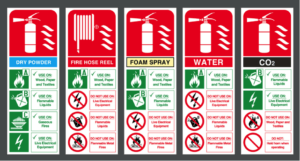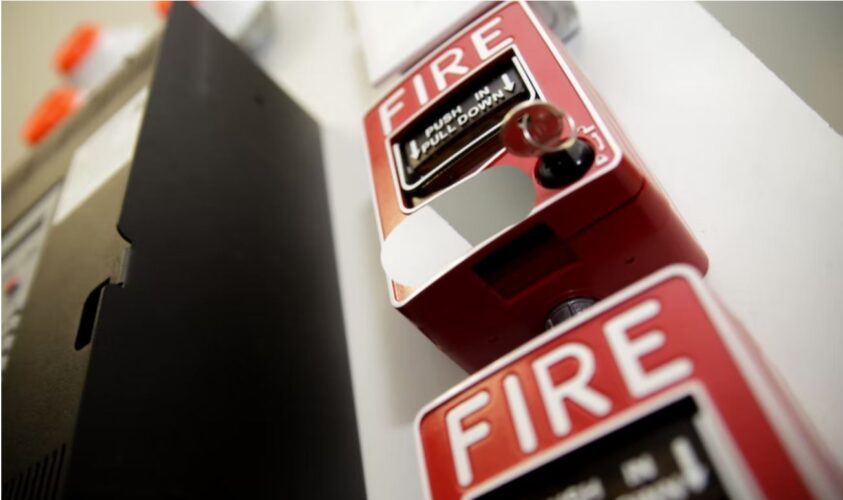Having a fire in the workplace can be devastating for your business, and some businesses never recover. Understanding the potential fire hazards in your office is the first step in limiting the risks.
Common office fire safety risks
Damaged power cords
Power cords are everywhere in offices. Whether powering a computer, a lamp or the kettle in the kitchen, they’re unavoidable. The problem is that over time, the wire casing can become worn and expose the wire inside. This creates a risk of electrical shock and sparks that could start a fire if they land on flammable material. It is vital that wiring for all electrical equipment is inspected on a regular basis and replaced if necessary.
Combustible materials
The nature of most offices means that there are combustible materials abound, which provides fuel for fires. Combustible materials include loose paper, waste bins, and furnishings. To reduce the risk, it’s important to take steps to keep offices tidy. You shouldn’t store waste inside the building, and a clean desk policy, with paper stored away in filing cabinets, keeps the potential fuel to a minimum.
Choose office furniture (e.g. chairs, sofas and desks) that is made from fire resistant materials to reduce the risk of it going up in flames.
Blocked walkways and fire escapes
This point is linked to the one about about keeping offices tidy. If there is a fire, people’s lives could depend on being able to escape. It is vital that corridors and fire exits are kept clear at all times.
You also must not prop open fire doors, for example with a fire extinguisher, as the fire door is designed to keep fire at bay for a certain amount of time. If the door cannot close the fire could spread easily and inhibit escape.
Extension leads
Extension leads are often used because there aren’t always enough plug sockets in offices, but you should only use them if absolutely necessary. Not using an extension lead properly carries a risk of electric shock and fire. If you overload a extension lead it can overheat and burst into flames.
If you do use an extension lead make sure you don’t plug in too many appliances at once; buy the lead from a reputable retailer so it’s guaranteed to be safe; stop using it straightaway if you suspect it’s faulty or overheating.
Computer equipment and laptops
Computer equipment is considered to be very safe and does not pose much of a fire risk. There is not much you can, or need to do, to reduce the risk of fire due to a computer. However, they can potentially have an electrical fault, such as the cooling fan breaking down, so you should keep flammable items, such as paper, at a distance from monitors and CPUs.
To prevent laptops from overheating, they should only be used on hard surfaces such as desks.
Fire safety risk assessments
It is essential that a fire risk assessment is carried out to meet the Regulatory Reform (Fire Safety) Order 2005. The Order basically states that any person with a level of control in a premises must take reasonable steps to reduce the risk from fire, and make sure people can safely escape if there is a fire.
Identify fire hazards
The first step in a fire risk assessment is to identify the hazards. For fires this includes sources of ignition (e.g. naked flames or heaters), sources of fuel (e.g. piles of rubbish bags, display materials, reams of paper) and sources of oxygen (e.g. air conditioning).
Identify people at risk
The next step is to identify people at risk. This includes staff and visitors, highlighting those people who are particularly at risk, such as people working alone or in isolated areas.
Evaluate, remove or reduce, and protect from risk
Next, evaluate the risk of a fire starting and the potential risk to people from a fire. Then take steps to remove or reduce those risks and protect people by providing fire precautions.
Record, plan, inform, instruct and train
Record major findings and the actions you have taken. Work with other responsible people in your organisation to prepare an emergency plan, inform relevant people, and provide training.
Review
Remember to review your fire-risk assessment regularly and make any changes where necessary.
General fire precautions
Within your workplace, as a bare minimum, you should have a fire detection and warning system, and a method of fighting a small fire.
Your fire-detection and warning systems doesn’t have to be all bells and whistles. It could be as simple as a shouted warning in a small office, however you must be able to warn people in all circumstances.
In some environments, multi-purpose fire extinguishers with a guaranteed shelf life will be acceptable as fire fighting tools. The Government suggests the rule of thumb is that you should have one extinguisher for every 200m2 of floor space, with at least one on each floor.
Main types of portable extinguishers
| Type of Extinguisher | Suitable for use on | DO NOT USE ON |
| Dry Powder | Liquid, electrical and gaseous fires | Metal fires |
| Foam Spray | Liquid fires | Electrical or metal fires |
| Water | Wood, paper, textile and solid material fires | Liquid, electrical or metal fires |
| Carbon dioxide | Liquid and electrical fires | Metal, wood, paper or textile fires |
These stickers are usually found on fire extinguishers:

Image credit: Jovanovic Dejan/Shutterstock.com
Fire risk assessment from SAMS
We offer a complete fire risk assessment service, providing you with a simple and cost effective process to manage fire risks at your business or event which meets the requirements of the Regulatory Reform (Fire Order) 2005. Click here to find out more about our fire risk assessment service.

